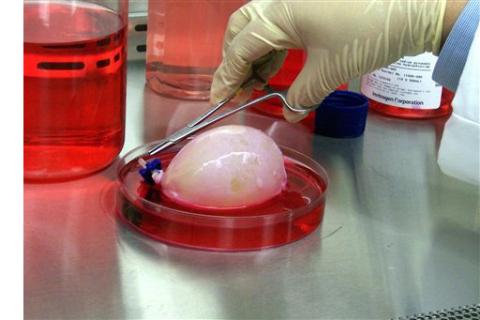Imagine a world where there is no organ donor shortage, where victims of spinal cord injuries can walk, and where weakened hearts are replaced. This is the long-term promise of regenerative biology and tissue engineering, a rapidly developing field with the potential to transform the treatment of human disease through the development of innovative new therapies.
 Tissue engineering refers to the practice of combining scaffolds, cells, and biologically active molecules into functional tissues. The goal of tissue engineering is to assemble functional constructs that restore, maintain, or improve damaged tissues or whole organs. Artificial skin and cartilage are examples of engineered tissues that have been approved by the FDA, however, currently they have limited use in human patients.
Tissue engineering refers to the practice of combining scaffolds, cells, and biologically active molecules into functional tissues. The goal of tissue engineering is to assemble functional constructs that restore, maintain, or improve damaged tissues or whole organs. Artificial skin and cartilage are examples of engineered tissues that have been approved by the FDA, however, currently they have limited use in human patients.
 Regenerative medicine is a broad field that that includes tissue engineering but also incorporates research on self-healing, where the body uses its own systems, sometimes with the help of biological materials to recreate cells and rebuild tissues and organs. The fields "tissue engineering" and "regenerative medicine" intertwine to focus on cures for complex, often chronic diseases.
Regenerative medicine is a broad field that that includes tissue engineering but also incorporates research on self-healing, where the body uses its own systems, sometimes with the help of biological materials to recreate cells and rebuild tissues and organs. The fields "tissue engineering" and "regenerative medicine" intertwine to focus on cures for complex, often chronic diseases.
Genomics provides insight into gene expression during development that can be used to dissect mechanisms of regeneration and the differentiation of stem cells. Our laboratory part of an innovative interdisciplinary approach to harvesting gene expression information to create design rules for stem cell biology, regenerative medicine and tissue engineering. The goal of the Regenerative Biology & Tissue Engineering (RbTE) theme at the Institute for Genomic Biology is to develop the knowledge base and technologies that are needed to replace or regenerate human tissues and organs adn thereby solve these severe health issues and contribute to improving life quality and welfare.
Research includes utilization of laser capture microscopy, construction of microfluidic devices, and the development of comparative phenomics to dissect regeneration using the mouse, pig and planeria models.
